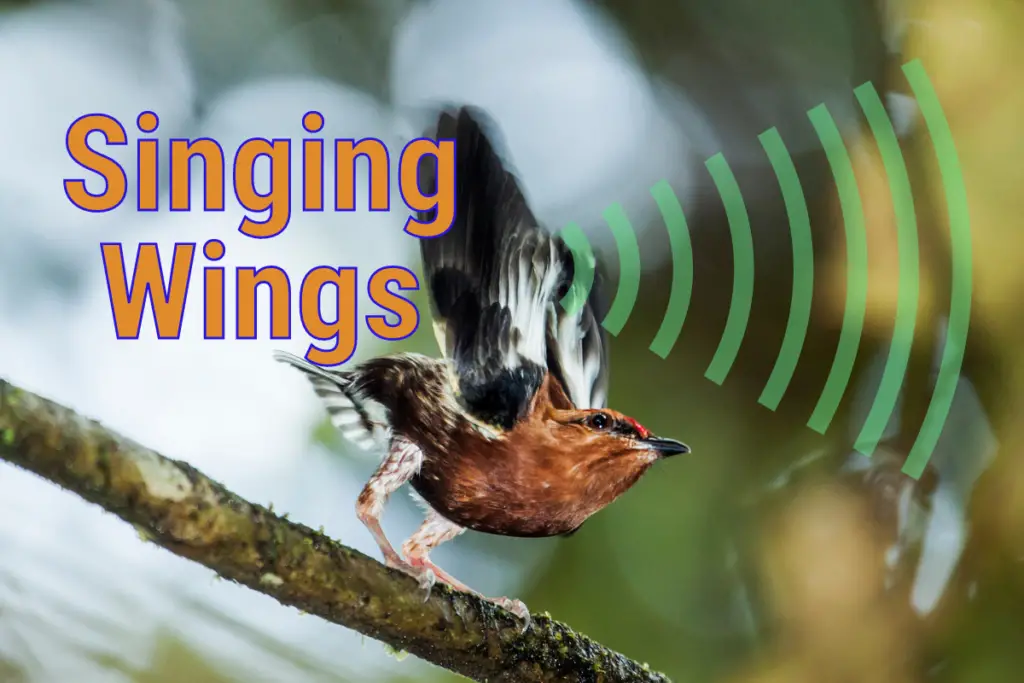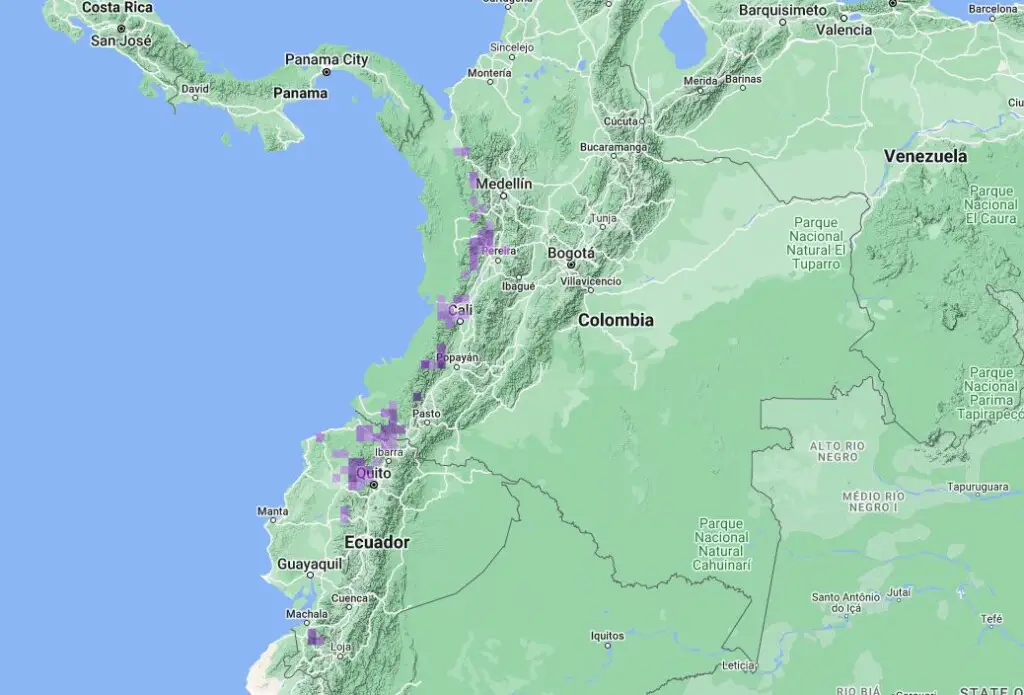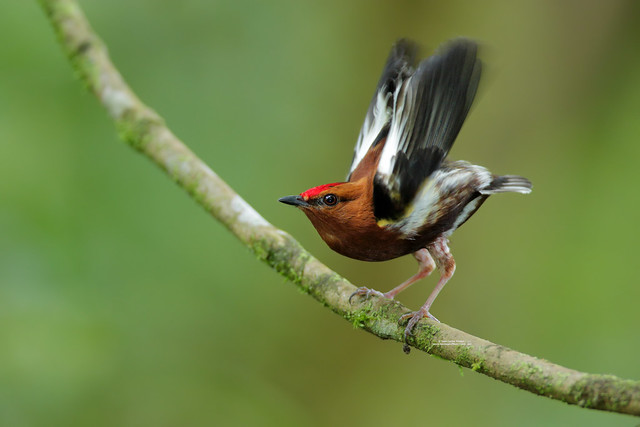
Just when you think you’ve learned everything there is to know about birds, you come across another one that just blows your mind. While researching for another article on how birds fly, I stumbled upon the Club-winged Manakin. Its remarkable singing wings will leave you stunned.
The Club-winged Manakin is said to have singing wings as it can produce a tone with its wings. By vibrating its wing tips together at 107 Hz, this tiny South American bird can make a high-pitched buzzing tone. Male club-winged manakins use this technique in mating displays to attract females.
Continue reading to learn more about the incredible Club-winged Manakin. I am going to show you video footage of this bird in action and reveal the secret behind its marvelous singing wings.

As an Amazon Associate, I earn from qualifying purchases. Birdwatch World earns commissions from Amazon and similar affiliate programs from any purchases made via links in this article.
Meet The Club-winged Manakin

The Club-winged Manakin is a member of the Manakin or Pipridae family. These birds have large heads, and short tails and inhabit the Neotropical forests of Central and South America.
Manakins are what is called Dimorphic, meaning the males and females are strikingly different in appearance. Females are plain olive-green while the males are black or white with vibrant patches of red, yellow, or blue.
The image below from Bradley Hacker shows the female of the species:

There are 53 species of Manakin. The club-winged manakin is not the only one that can produce a tone with its wings. Other bird species are capable of producing sound with their wings but the club-winged manakin stands apart as the only bird that can make a tonal sound like a cricket.

Club-winged manakins are tiny birds, measuring just 9.5-10 cm (3.7-3.9 in.). Male birds are mostly chestnut-brown with a scarlet crown and forehead and a dusky eyestripe. They are darker brown on the belly with some white flecks.
However, it is those wings we are most concerned with here.
Singing Wings Of The Club-winged Manakin
The wings of this unique little bird are black with white areas and yellow on the shoulder. However, it is their shape that is special, which you might have noticed in the first image above. There is much more than meets the eye with these feathers.
During a mating display, the male club-winged manakin will flip its wings above its back and knock them together. This produces a high-pitched, violin-like tone.
What on Earth is going on here? How is this bird able to make this sound with its wings?
Learn how birds hear in this article on my blog.
A Unique Wing Design
Normally, if you took two bird feathers and rubbed them together, they would make hardly any sound at all. The resulting sound might be something like two pages of paper rubbing together, certainly not a musical tone such as this bird produces.
The secret here is in the shape and design of the secondary feathers.

In the images above the first thing that should stand out to you are the 5th, 6th, and 7th secondary feathers (Fig. A). Notice the shape of the shafts (rachis) of the 6th and 7th feathers, they are very thick and club-like, hence the name club-winged manakin.
In addition to their club-like shape, these secondary feathers also have ridges along one edge of the rachis (Fig. C). The 5th secondary feather bends at an angle toward the end of its rachis, resembling something akin to a guitar pick.
When the club-winged manakin rubs these parts of its wings together at 107 cycles per second, it produces the tone heard in the video above. This is the same technique crickets use to make their chirping sound.
I will let Kimberly Bostwick from Cornell University explain it to you:
The Sound Of The Singing Wings
You may be a little confused that the sound resulting from this bird knocking its wings together is a continuous note and not just a clicking sound. This has to do with the rate at which it’s happening and also exactly what is happening.
I have told you that the bird vibrates its wings at 107 Hz or 107 times every second. When the tone is measured, it is around 1.5 kHz. Play the sound below to hear this:
If we do some simple math here, we realize that when a club-winged manakin vibrates his wings, something must be happening 14 times within every second:
107 X 14 = 1498
The reason this happens is that there are 7 ridges on the rachis of the “washboard” feather. As the pick feather crosses over it, it contacts the 7 ridges on the way in and again on the way back for a total of 14 points of contact.
Kimberly Bostwick from Cornell University explains in this video:
Where To Find The Club-winged Manakin
You will find these musical birds on the Western slopes of the Andes Mountains from southwest Columbia down through western Ecuador.
They can be found between 600 to 1900m (1969-6234 ft) above sea level. In Ecuador, they are found only up to 1600m (5249 ft). They prefer wet forests, especially where it is mossy.

Discover more mind-blowing birds of South America here in this article.
Listen To The Singing Wings
Club-winged manakins will often combine their wing sounds with a high-pitched vocal ‘seet’ or ‘seet-seet’. Listen to various calls and wing noises below:
In this first recording, you can hear the little click tone just before the long, droning note. It is almost like the bird does this as a test tone, kind of like tuning up its instrument. You can also hear the vocal sounds in-between tones.

This recording features at least four male birds at a lek (courtship display area). You can really hear the reverberative qualities of the wing sound in this one. It must be so loud when heard close up.
Conclusion
The club-winged manakin is yet another wondrous creation of nature. The world of birds continues to amaze and fascinate me every day.
I traveled to Ecuador back in 2005. I wonder if I heard the club-winged manakin and didn’t know it? I would love to get back there someday and seek them out deep within the forests of the Andes.
References
- birdsoftheworld.org – The Cornell Lab of Ornithology
- Singing Wings Behavior – The Cornell Lab of Ornithology’s Bird Academy
- Singing Wings Sounds – The Cornell Lab of Ornithology’s Bird Academy
- Singing Wings Feathers – The Cornell Lab of Ornithology’s Bird Academy
- Singing Wings Solution – The Cornell Lab of Ornithology’s Bird Academy
- The Handbook of Bird Biology – The Cornell Lab of Ornithology
